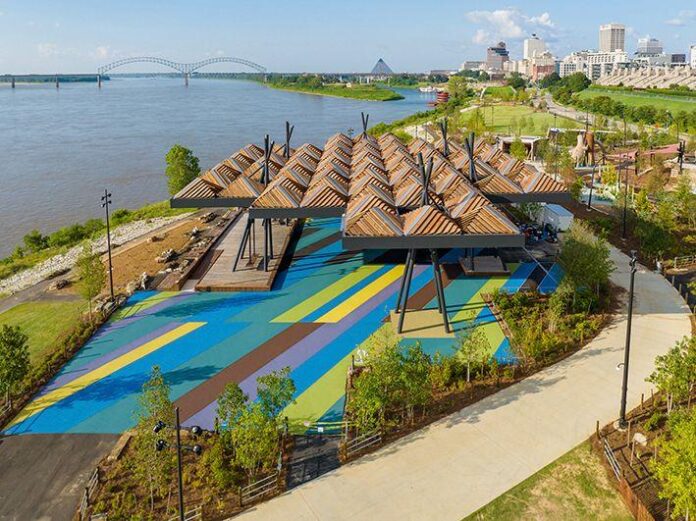On 31 acres of prominent Memphis real estate bordering the Mississippi River, Tom Lee Park reopened on 2 September after a $61m investment and six years of planning and work by the architectural firm Studio Gang and park designer Scape. Besides 1,000 new trees and a greatly enhanced landscape for people and pollinators, two new permanent public art installations by Theaster Gates and James Little are being unveiled—each aiming to create sites for the community to come together, in play and contemplation.
“Memphians historically have been cut off from their riverfront and it’s way past time we had good access to it,” says Carol Coletta, Memphis River Parks Partnership president and chief executive. The park is named after a Black skiff boat operator who witnessed the capsizing of a steamer ship in 1925 and single-handedly rescued 32 people from drowning in the Mississippi. Coletta invited Gates, the Chicago-based interdisciplinary artist, to commemorate Lee and his heroism by creating some kind of monument.
Gates answered the call with A Monument to Listening (2023), including 32 dark basalt pillars carved into throne-like sculptures. He has configured 28 of these in radiating concentric circles, with the four other sculptures nearby at the water’s edge joined by a taller throne as a stand-in for Lee overlooking the river.
“Memphis lives between a very Black world and a very white world, and is a place that’s always held a bit of tension around who deserves the right to gather,” says Gates, whose family always stopped in Memphis as the midpoint on trips from Chicago to Humphreys County, Mississippi, to visit relatives.

Theaster Gates, A Monument to Listening (2023), at Tom Lee Park in Memphis © Connor Ryan
The Memphis River Parks Partnership collaborated with the non-profit organisation Project Backboard to work with Little, the New York-based painter born and raised in Memphis, on a second site-specific commission. It spans the surface of a full basketball court and two half courts under a soaring outdoor pavilion designed by Studio Gang called Sunset Canopy.
“Basketball courts are like training grounds for citizenship where a group of strangers from a community can shoot hoops and solve a problem together in a public space,” says Daniel Peterson, the founder of Project Backboard, which works with artists to create works on basketball courts.
Little chose to adapt his 2017 painting, Democratic Experiment—with bands of hard-edged, staccato diagonal segments in a moody palette of cerulean blue, teal, tea green, mustard, lilac and brown—now scaled up to span 20,000 sq. ft. Little says: “The tension and movement and idea that things are continuing to change and evolve—that’s the way our democracy is.”

























